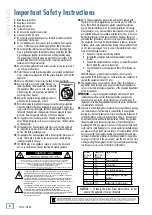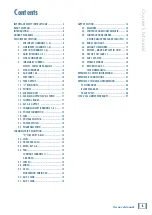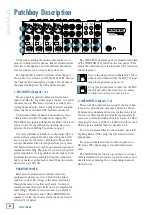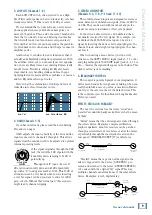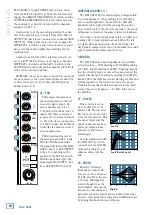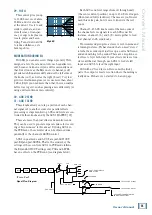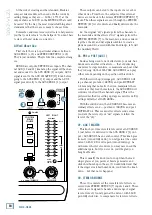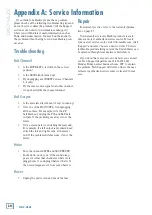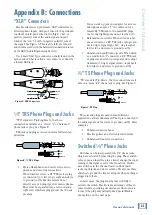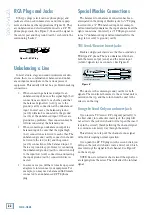
9
Owner’s Manual
Owner’
s Manual
5. STEREO LINE INPUTS
(Channels 5–6, 7–8, 9–10 and 11–12)
These fully balanced inputs are designed for stereo or
mono, balanced or unbalanced signals, from –10 dBV to
+4 dBu. They can be used with just about any profes-
sional or semi-pro instrument, effect or tape player.
In the stereo audio world, an odd-numbered chan-
nel usually receives the “left signal.” For example, you
would feed the 1202-VLZ3’s line inputs 5-6 a stereo
signal by inserting the device’s left output plug into the
channel 5 jack, and its right output plug into the chan-
nel 6 jack.
When connecting a mono device (just one cord),
always use the LEFT (MONO) input (jacks 5, 7, 9 or 11)
and plug nothing into the RIGHT input (jacks 6, 8, 10 or
12)— this way the signal will appear on both sides. This
trick is called “jack normalling.”
6. IMAGINARY CONTROL
This control is purely a figment of our imagination. It
will come in handy after long hours of mixing, when you
really would like a nice cup of tea, a vacation in Hawaii,
or a trip to the outer reaches of the Solar System. This
is the control for you. Be thankful, you bought a Mackie.
We love you man!
EFFECTS: SERIAL OR PARALLEL?
The next two sections toss the terms “serial” and
“parallel” around like hacky sacks. Here’s what we mean
by them:
“Serial” means that the entire signal is routed through
the effects device. Examples: compressor/limiters,
graphic equalizers. Line-level sources can be patched
through a serial effects device before or after the mixer,
or preferably through the insert jacks located on the
rear panel (CHANNEL INSERT [17] send/return).
“Parallel” means that a portion of the signal in the
mixer is tapped off to the device (AUX SEND), pro-
cessed and returned to the mixer (STEREO RETURN)
to be mixed with the original “dry” signal. This way,
multiple channels can all make use of the same effects
device. Examples: reverb, digital delay.
3. LOW CUT (Channels 1–4)
Each LOW CUT switch, often referred to as a High
Pass Filter (all depends on how you look at it), cuts bass
frequencies below 75 Hz at a rate of 18 dB per octave.
We recommend that you use low-cut on every micro-
phone application except kick drum, bass guitar, or
bassy synth patches. These aside, there isn’t much down
there that you want to hear, and filtering it out makes
the low stuff you do want much more crisp and tasty.
Not only that, but low-cut can help reduce the possibili-
ty of feedback in live situations, and it helps to conserve
amplifier power.
Another way to consider low-cut’s function is that it
actually adds flexibility during live performances. With
the addition of low-cut, you can safely use low equaliza-
tion on vocals. Many times, bass shelving EQ can really
benefit voices. Trouble is, adding low EQ also boosts
stage rumble, mic handling clunks and breath pops.
Applying low-cut removes all those problems, so you can
add low EQ without losing a woofer.
Here’s what the combination of low EQ and low-cut
looks like in terms of frequency curves:
4. GAIN (Channels 1–4)
If you haven’t already, please read the Level-Setting
Procedure on page 3.
GAIN adjusts the input sensitivity of the mic and line
inputs connected to channels 1 through 4. This allows
signals from the outside world to be adjusted to optimal
internal operating levels.
If the signal originates through the XLR
jack, there will be 0 dB of gain with the
knob fully down, ramping to 60 dB of
gain fully up.
Through the 1⁄4" input, there is 15
dB of attenuation fully down and 45 dB of gain fully
up, with a “U” (unity gain) mark at 10:00. This 15 dB of
attenuation can be very handy when you are inserting
a very hot signal, or when you want to add a lot of EQ
gain, or both. Without this “virtual pad,” this scenario
might lead to channel clipping.
Dry Signal
Processed
Signal
Insert
Send
Insert
Return
Dry Signal(s)
Dry Signal(s)
Aux
Send
Aux
Return
Wet Signal
Channel Path
Mix
Stage
Output
Section
Processed
Signal
Signal Processor
(e.g., Compressor)
Signal Processor
(e.g., Reverb)
Dry Signal
Processed
Signal
Insert
Send
Insert
Return
Dry Signal(s)
Dry Signal(s)
Aux
Send
Aux
Return
Wet Signal
Channel Path
Mix
Stage
Output
Section
Processed
Signal
Signal Processor
(e.g., Compressor)
Signal Processor
(e.g., Reverb)
Low Cut with Low EQ
20
Hz
100
Hz
1k
Hz
10k
Hz
20k
Hz
–15
–10
–5
0
+5
+10
+15
20
Hz
100
Hz
1k
Hz
10k
Hz
20k
Hz
–15
–10
–5
0
+5
+10
+15
Low Cut
POWER
ON
PHANTOM
ON
L MAIN
MAIN
OUTPUT
LEVEL
4
3
R/4
L/3
CHANNEL INSERT
BAL/UNBAL
BALANCED
BAL/UNBAL
ALT
OUTPUT
R
L
CONTROL
ROOM
SERIAL NUMBER
MANUFACTURING DATE
RISK OF ELECTRIC SHOCK
DO NOT OPEN
REPLACE WITH THE SAME TYPE FUSE AND RATING.
DISCONNECT SUPPLY CORD BEFORE CHANGING FUSE
UTILISE UN FUSIBLE DE RECHANGE DE MÊME TYPE.
DEBRANCHER AVANT DE REMPLACER LE FUSIBLE
WARNING:
TO REDUCE THE RISK OF FIRE OR ELECTRIC SHOCK, DO NOT
EXPOSE THIS EQUIPMENT TO RAIN OR MOISTURE. DO NOT REMOVE COVER.
NO USER SERVICEABLE PARTS INSIDE. REFER SERVICING TO QUALIFIED PERSONNEL.
CAUTION
AVIS:
RISQUE DE CHOC ELECTRIQUE — NE PAS OUVRIR
2
1
( PRE-FADER / PRE EQ TIP SEND / RING RETURN )
XDR
TM
EXTENDED DYNAMIC RANGE MIC PREAMPLIFIERS ARE PROPRIETARY TO MACKIE DESIGNS, INC.
-10
dBV
GAIN
+15dB -45dB
M
IC GAIN
0
U
60
LINE IN 1
MIC
1
LOW CUT
75 Hz
18dB/OCT
LOW CUT
75 Hz
18dB/OCT
LOW CUT
75 Hz
18dB/OCT
LOW CUT
75 Hz
18dB/OCT
BAL
OR
UNBAL
LINE IN 2
MIC
2
BAL
OR
UNBAL
LINE IN 3
MIC
3
BAL
OR
UNBAL
LINE IN 4
MIC
4
BAL
OR
UNBAL
AUX SEND
1
2
1
2
R
R
L
L /MONO
ALL BAL/UNBAL
TAPE
INPUT
TAPE
OUTPUT
L
R
L
R
L
R
MAIN OUT
BAL/UNBAL
L
MONO
MONO
MONO
MONO
LINE IN 5–6
R
LINE IN 7–8
LINE IN 9–10
LINE IN 11–12
BAL
OR
UNBAL
L
R
BAL
OR
UNBAL
L
R
BAL
OR
UNBAL
L
R
BAL
OR
UNBAL
XDR
MIC PRE
XDR
MIC PRE
XDR
MIC PRE
XDR
MIC PRE
GAIN
+15dB -45dB
M
IC GAIN
0
U
60
-10
dBV
GAIN
+15dB-45dB
M
IC GAIN
0
U
60
-10
dBV
GAIN
+15dB -45dB
M
IC GAIN
0
U
60
-10
dBV
O
O
+15
O
O
+15
AUX
+15
-15
+15
-15
+15
-15
HI
12kHz
MID
2.5kHz
LOW
80Hz
HI
12kHz
MID
2.5kHz
LOW
80Hz
HI
12kHz
MID
2.5kHz
LOW
80Hz
HI
12kHz
MID
2.5kHz
LOW
80Hz
HI
12kHz
MID
2.5kHz
LOW
80Hz
HI
12kHz
MID
2.5kHz
LOW
80Hz
HI
12kHz
MID
2.5kHz
LOW
80Hz
HI
12kHz
MID
2.5kHz
LOW
80Hz
EQ
L R
1
MUTE
PAN
AUX
EQ
PAN
AUX
EQ
PAN
AUX
EQ
PAN
AUX
EQ
PAN
AUX
EQ
PAN
AUX
EQ
PAN
AUX
EQ
PAN
ALT 3–4
MUTE
ALT 3–4
MUTE
ALT 3–4
MUTE
ALT 3–4
MUTE
ALT 3–4
MUTE
ALT 3–4
MUTE
ALT 3–4
MUTE
ALT 3–4
PRE FADER
SOLO
LEVEL
2
PRE FADER
SOLO
LEVEL
3
PRE FADER
SOLO
LEVEL
4
PRE FADER
SOLO
LEVEL
5/6
PRE FADER
SOLO
LEVEL
7/8
PRE FADER
SOLO
LEVEL
9/10
PRE FADER
SOLO
LEVEL
11/12
PRE FADER
SOLO
LEVEL
POWER
RUDE
SOLO
LIGHT
LEVEL
SET
CONTROL
ROOM
SOURCE
ALT 3–4
TAPE
MAIN MIX
CLIP
LEFT RIGHT
0dB=0dBu
ASSIGN
TO MAIN MIX
MAIN MIX
/SUBMIX
CTL ROOM
+12dB
O
O
U
+12dB
O
O
U
+12dB
O
O
U
+12dB
O
O
U
+12dB
O
O
U
+12dB
O
O
U
+12dB
O
O
U
+12dB
O
O
U
MAX
O
O
U
+12dB
O
O
U
U
U
O
O
+15
O
O
+15
U
U
O
O
+15
O
O
+15
U
U
O
O
+15
O
O
+15
U
U
U
U
U
+15
-15
+15
-15
+15
-15
L R
U
U
U
+15
-15
+15
-15
+15
-15
L R
U
U
U
+15
-15
+15
-15
+15
-15
L R
U
U
U
+15
-15
+15
-15
+15
-15
L R
U
U
U
+15
-15
+15
-15
+15
-15
L R
U
U
U
+15
-15
+15
-15
+15
-15
L R
U
U
U
+15
-15
+15
-15
+15
-15
L R
U
U
U
O
O
+15
O
O
+15
U
U
O
O
+15
O
O
+15
U
U
O
O
+15
O
O
+15
U
U
O
O
+15
O
O
+15
U
U
20
10
7
4
2
0
2
4
7
10
20
30


